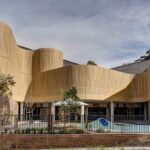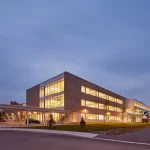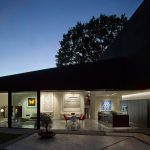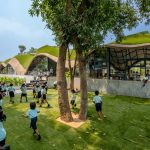St Silas School, Blackburn Education Building, Architect, Lancashire Design
St Silas Primary School : Blackburn Building
Primary, north west England – design by Capita Symonds
RIBA Awards 2013 : RIBA National Award Winner – 13 Jun 2013
3 Jun 2012
St Silas Primary School in Blackburn
Capita Symonds Unveils Unique Primary School New ‘total BIM’ design in historic industrial town
Design: Capita Symonds
Capita Symonds has released images of the new £7.5million St Silas Primary School in Blackburn, Lancashire.
Working on behalf of Blackburn with Darwen Borough Council, in partnership with the local LEP, Capita Symonds provided a full range of multidisciplinary services – including architecture, structural engineering, mechanical and electrical engineering, landscape architecture, cost consultancy, acoustics, project management, fire engineering, planning and transport planning – for the two form entry, 420 pupil school.


photos : Capita Symonds / Nick Guttridge
The recently opened three storey building was designed on a small, sloping, urban 2400 sqm site in just eight weeks in the summer of 2010 using BIM as a full multidisciplinary tool.
Located in a dense grid of Victorian workers’ terraces, one mile north west of Blackburn town centre, the site is in the heart of a thriving community which has a large proportion of Indian and Pakistani residents. With 99% of pupils hailing from an Islamic background, this Church of England-run school provides an interesting example of cross community engagement and social mixing.
BIM techniques were utilised by the Capita Symonds team to accelerate the design process, enabling hand drawn concepts to be worked into three dimensions which were shown to the school and local community as part of the engagement process, with a final scheme reached in just a few weeks.
Working directly with the Local Education Partnership – SHINE – and its contactor partner Balfour Beatty, also meant cost and programme certainty could be insured allowing demolition of the existing school to be undertaken just days after planning consent was obtained.
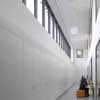
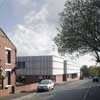
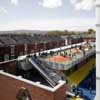
photos : Capita Symonds / Nick Guttridge
The primary challenge of the scheme design was the size of the existing site which, at just 60 metres by 40 metres, was considerably less than the typical recommended BB99 site allowance. In a bid to provide all classrooms with direct access to external play space, the team utilised the area’s topography, resulting in a three storey solution totalling 2200 sq m which is layered over and pushed into the site and terraced to maximise the external area with rooftop play spaces, while using level changes advantageously to create a simple, inspiring solution.
The project comprises four linked blocks wrapping around a secure play courtyard: a single storey block with a rooftop play deck linked to the ground with a tube slide; two three-storey blocks linked by a bridge of class spaces of which the upper floor houses a mini-football pitch; and finally a main hall block with staff accommodation on top disguising plant areas. This design allows for over 800 sq m of useable play space off the ground level, over 400 sq m more than was previously provided on the existing flat site.
The disposition of the interlocking blocks is laid out to maximise teaching spaces and allow different learning styles with flexible indoor and outdoor teaching areas. The year groups spiral up in plan around the courtyard with the eldest at the top of the school. The flow between these blocks allows flexibility for whole school activity and community events while the library is accessible from the main foyer and acts as a bridge through the hall with a large window to the street, again encouraging community and parental use. The pivotal internal space in the school – a ‘through’ entrance hall – is focused on a cascade of giant steps, acting as a central gathering space to provide a stopping point in the mornings, a special space for learning, or even a small performance venue.
The play of light and colour is deliberate throughout the school, with coloured perspex step in-fills flooding dining areas with a rainbow of light. The ‘wrapping’ elevation cladding system is a series of coloured, translucent and solid perspex fins designed to create a cost effective rapid solution to enclose the otherwise relatively cheap envelope. This allows the building to appear as a whole mass, but also breaks up the facades as the viewer moves past the building with the whole exuding a playful mix of transparency and lightness.
The locally sourced perspex (from Darwen, just a few miles away within the borough) creates quick and ‘cropped’ reflections of the local context when viewed in passing and adds to the ‘layering’ of form, colour and transparency to create a unique learning environment in a very special place.
Early in the process the team worked with community leaders and identified a need for a public space on the high street that passes the site. As a result, 20% of the whole site has been given back to the community in the form of formal and informal gardens. These will be maintained by the community working with the school and local authority.
St Silas Primary School Blackburn images / information from Capita Symonds Architects
Location: St Silas Primary School, Blackburn, Lancashire, Northwest England, UK
Northwest English Architecture
Contemporary Lancashire Buildings
Another Lancashire Building design by Capita Symonds on e-architect:
Fighter Jet Building, BAE Systems, Samlesbury
Fighter Jet Building
Lancashire Building Designs
Make Architects
Gary Neville House
Charles Carter Building, Lancaster University, north Lancashire
John McAslan + Partners
Charles Carter Building
Manchester Architecture Walking Tours
Beetham Tower – Tallest residential tower in Europe
Ian Simpson Architects
Manchester Hilton
Comments / photos for the St Silas Primary School Blackburn – Lancashire Education Building page welcome
Website: St Silas CE Primary School

